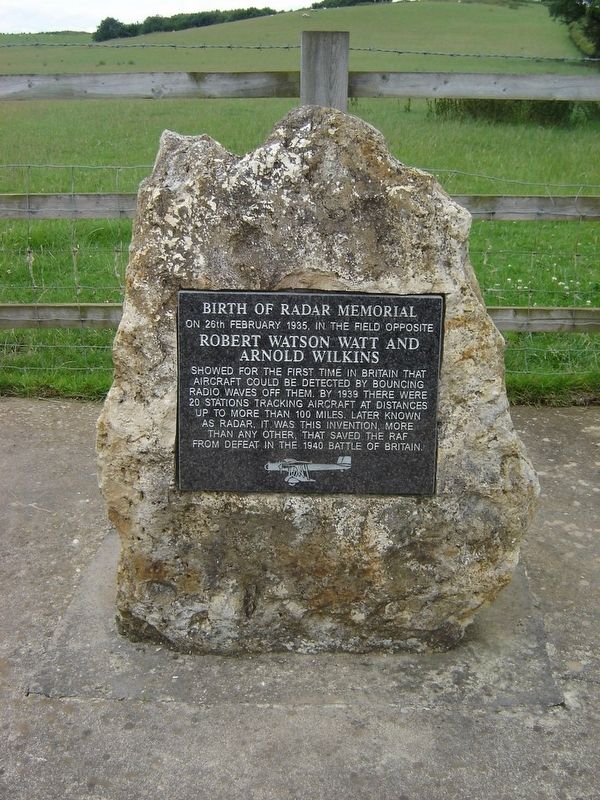Near Upper Stowe in Northamptonshire, England, United Kingdom — Northwestern Europe (the British Isles)
Birth Of Radar Memorial
Inscription.
On 26th February 1935, in the field opposite
Erected 2001 by QinetiQ Ltd. and Mrs. Nancy Wilson.
Topics. This historical marker and memorial is listed in these topic lists: Air & Space • Science & Medicine • War, World II. A significant historical date for this entry is February 26, 1935.
Location. 52° 11.759′ N, 1° 3.005′ W. Marker is near Upper Stowe, England, in Northamptonshire. Marker is on Litchboro Northampton Road just west of A5, on the left when traveling east. Touch for map. Marker is in this post office area: Upper Stowe, England NN12 8HR, United Kingdom. Touch for directions.
Other nearby markers. At least 1 other marker is within 23 kilometers of this marker, measured as the crow flies. The Old Gaol (approx. 22.1 kilometers away).
Regarding Birth Of Radar Memorial. Dipole aerials set up in a nearby field were used to test the theory that energy from radio signals could be deflected from an aircraft's body. On 26 February 1935 an RAF Handley Page bomber aircraft was flown over the site and the theory was proved.
Also see . . .
1. Robert Watson-Watt (Wikipedia). "Sir Robert Alexander Watson-Watt, KCB, FRS, FRAeS (13 April 1892 – 5 December 1973) was a British pioneer of radio direction finding and radar technology." (Submitted on November 22, 2019.)
2. Arnold Wilkins (Wikipedia). "Arnold Frederic Wilkins OBE (20 February 1907 – 5 August 1985) was a pioneer in developing the use of radar. It was Arnold Wilkins who suggested to his boss, Robert Watson Watt, that reflected radio waves might be used to detect aircraft, and his idea led to the initial steps in developing ground-to-air radar in the UK. Wilkins also provided all the theoretical calculations to back-up his idea of aircraft detection, and it was his lashed-up system that he used in the Daventry Experiment to demonstrate that his idea would work. With the Daventry experiment, Wilkins successfully detected an aircraft (up to eight miles away) by reflection of radio waves for the first time in history." (Submitted on November 22, 2019.)
3. Chain Home - Daventry Experiment (Wikipedia). '...Wilkins suggested using the new 10 kW, 49.8 m BBC Borough Hill shortwave station in Daventry as a suitable ad hoc transmitter. The receiver and an oscilloscope were placed in a delivery van the RRS used for measuring radio reception around the countryside. On 26 February 1935, they parked the van in a field near Upper Stowe and connected it to wire antennas stretched across the field on top of wooden poles. A Handley Page Heyford made four passes over the area, producing clearly notable effects on the CRT display on three of the passes. A memorial stone stands on the site of the test.... Observing the test were Watt, Wilkins, and several other members of the RRS team, along with Rowe representing the Tizard Committee. Watt was so impressed he later claimed to have exclaimed: "Britain has become an island again!"' (Submitted on November 22, 2019.)
4. Castles in the Sky. A 2014 UK film "Castles in the Sky" stars Eddie Izzard as Robert Watson Watt, the pioneer of Radar who, with his hand-picked team of eccentric yet brilliant meteorologists, struggles to turn the concept of Radar into a workable reality, although hamstrung by a tiny budget, initial failures, and seemingly insurmountable technical problems. (Submitted on November 17, 2019, by Frederick Bothwell of Georgetown, Texas.)
5. British War Memorials Online. War Memorials Online is the website managed by the British War Memorials Trust which aims to collect information about the condition of war memorials across the UK. There are an estimated 100,000 war memorials in the UK. (Submitted on November 17, 2019.)
Credits. This page was last revised on January 27, 2022. It was originally submitted on November 16, 2019, by Frederick Bothwell of Georgetown, Texas. This page has been viewed 258 times since then and 24 times this year. Photo 1. submitted on November 16, 2019. • Andrew Ruppenstein was the editor who published this page.
